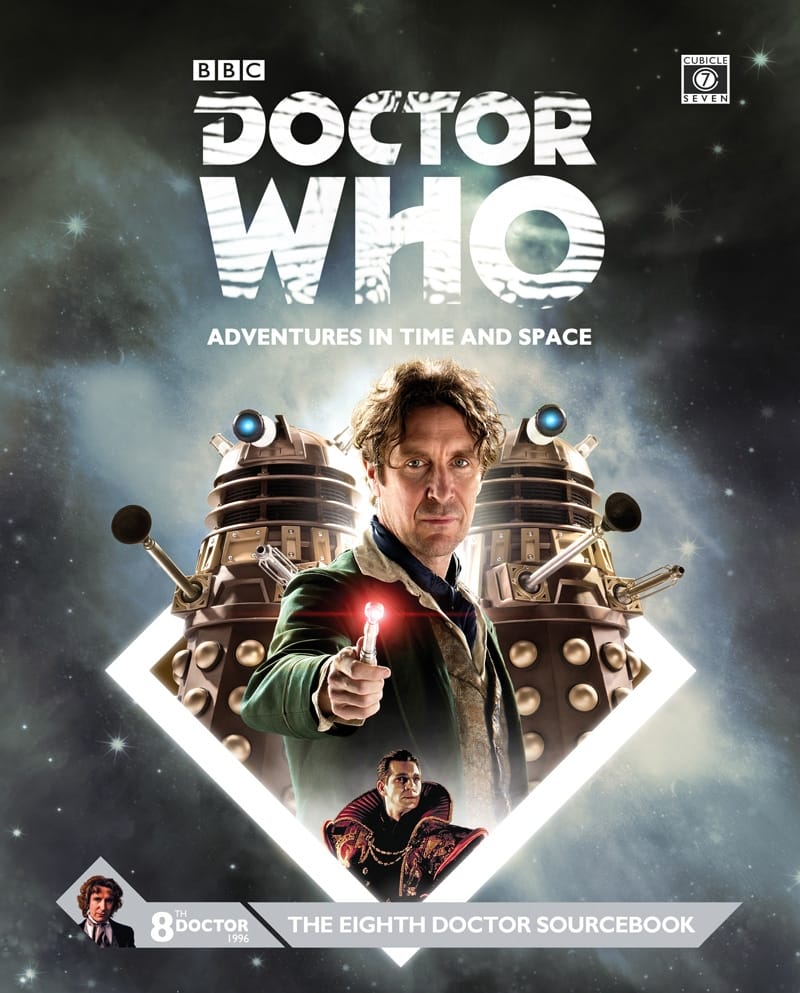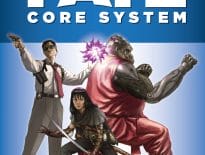
The Eighth Doctor Sourcebook on RPGNow
I saw a picture of Sylvester McCoy on the cover of the Doctor Who magazine yesterday. Age suits him, as do his sideburns. For some reason, by this morning, his image had reminded me of adventures past, probably because I’ve been reading Cubicle 7’s Eighth Doctor Sourcebook.
While previous Sourcebooks have served up descriptions of each Doctor’s stories, with associated stats for characters, monsters and ways to use these details in play, the Eighth Doctor didn’t hang around long enough to amass more than two stories – his first and his last.
So, what to do when you have 192-pages to fill?
Adventures. More adventures.
Form
The version of The Eighth Doctor Sourcebook I’m reviewing is the electronic one. However, you can also pick up a fine hardbound edition if you care to and prefer the hands-on experience of a book at the gaming table.
The PDF, from Cubicle 7, is 192-pages in length and filled with images that span the full range of The Doctor’s adventures. Most of the time, the images swing relatively close to the adventures but not necessarily spot on. So, a pirate adventure – echoing the historical stories of the First Doctor – uses images from The Curse of the Black Spot; one involving a scientific team exploring a hostile alien city uses shots from The Satan Pit and Silence in the Library. The pictures work for setting the mood, but probably won’t suit for in-game reference or show-and-tell handouts to the players.
The PDF adopts the two-column format common to books in the ongoing series, with boxed information presenting gadgets, alternate storylines and similar.
I came across few minor errors in grammar and nothing mechanically wrong – though I willing defer to those who might have longer experience in running the game.
Features
From the outset, I must say I found the idea behind this supplement refreshing and something of a relief. While the previous Sourcebooks have been excellent, the Doctor Who has become rather heavy with supplements and not nearly enough ready-to-play adventures. While Cubicle 7 has published a few one-off PDF adventures (like The Ravens of Despair and Medicine Man), I’ve always been hankering for more original material.
The Eighth Doctor Sourcebook presents a summary of Paul McGann’s Doctor and his televised stories before it launches into a linked campaign. You get an adventure associated with each incarnation of the Doctor, with bookend adventures to kick-off and conclude the sequence. All rather neat.
While the adventures vary considerably in style and substance, The Doctor’s presence always stamps some sort of mark on the sequence of events. Each adventure comes before or after an existing story or includes some reference or element imprinted with his presence.
The Seventh Doctor adventure, by way of example, relates to his Arthurian escapades in Battlefield. In that story, it became apparent that at some point the Doctor will adopt the guise of Merlin and tamper with matters, the way he tends to. So, the adventure picks up from that tidbit and weaves a tale about Merlin’s schemes in the other dimension where the forces of Arthur and Morgaine clash.
Here I return to Sylvester McCoy and the magazine cover.
See, it occurred to me – given Tom Baker’s recent reappearance as a possible future Doctor (“you might find yourself revisiting a few old faces, but just the old favourites, eh?“) – that it would be marvellous for the current Doctor to stumble on one of Merlin’s schemes. Given McCoy has fresh pedigree playing a cantankerous and bewildering old wizard, he could certainly revisit the role as another “old favourite” and team up with Capaldi.
Too much to ask?
Probably.
Anyway, back to the book.
So, the supplement does have all the information you might care to have regarding The TV Movie – including Eric Robert’s scenery-chewing turn as The Master – and the end of McGann’s tenure, broken on the surface of Karn, in Night of the Doctor. However, I believe the finest value for The Eighth Doctor Sourcebook comes from these adventures.
They do link, but I can see no trouble adapting them. Indeed, some of them feel slightly forced and out of place appearing in a sequence. The campaign conceit sees the characters trying to track down fragments of a temporal trace, scattered along The Doctor’s timeline. Sometimes, the trace feels a little like an afterthought – and I see this as advantageous for anyone wanting to run these adventures separately. They don’t need to be linked.
I recently ran the adventure Ice – aligned to the Tenth Doctor in theme and character – as an adventure for the Fifth Doctor and Nyssa, and everyone enjoyed it. The adventure runs well as a self-contained entity and nothing feels out of place whatever the set of characters.
For my tastes, some of the adventures feel a little vague and thin, like the pirate escapades of the first adventure, which somehow don’t benefit from the pictures of Hugh Bonneville. On the other hand, others emulate the feel of the associated period remarkably well – like the 3rd Doctor-style industrialist gone wrong in The Tendrils of Neox or the gastronomic excesses of Lunchtime of the Dead, with suitable 6th Doctor garish flair. I found myself smiling as I read. Lunchtime has more than a soupçon of Douglas Adams ingrained in the backdrop.
One thought before finishing off. Those who run adventures using characters from Torchwood or defending the earth with UNIT, or with a time machine that isn’t the TARDIS – you will not find yourself wanting. You will need to do a bit of legwork though.While you would stretch to get UNIT to some far off space station under their own steam, you could certainly use those adventures on Earth or just a dimensionally hop away. A few adventures specifically refer to groups using an alternate
While you would stretch to get UNIT to some far off space station under their own steam, you could certainly use those adventures set specifically on Earth or just a dimensionally hop away.
A few adventures specifically refer to groups using an alternate premise for play; others completely ignore it – which is a bit of shame. Considering the book offers a linked campaign, it simply won’t be possible to drop everything in front of your non-Gallifreyan characters without a little forethought and adjustment. An oversight, but nothing show-stopping.
For any GM who prefers to improvise or come up with her own stories, the book offers up plenty of seeds for potential development. You can easily snatch ideas, locations and adversaries, then transplant them somewhere else completely.
Final Thoughts
For anyone into the Doctor Who: Adventures in Time and Space roleplaying game, and keen for a few more adventures to run, I can recommend Cubicle 7’s Eighth Doctor Sourcebook. While the adventures provide the opportunity to run a linked campaign, I can see no reason to do so if you simply want more adventures.
Indeed, like Clara’s adventures – SPOILER ALERT – inside The Doctor’s timestream, these adventures could easily represent a clean-up operation, where the player controlled party put out fires left in the wake of the Doctor.
For me, any new adventures for Doctor Who: Adventures in Time and Space tick a very prominent box, so 192-pages packed with them isn’t something to sniff at.
And for anyone wondering, the book has some remarkably entertaining thoughts on the timeline of the Eighth Doctor and that business about him being half-human on his mother’s side…
My copy was provided for review. Doctor Who: The Eighth Doctor Sourcebook, Walt Ciechanowski, Andrew Kenrick, Andrew Peregrine, Gareth Ryder-Hanrahan, Gareth Michael Skarka, Graham Walmsley and Darren Watts, Cubicle 7, normally $19.99 in PDF.
Right now, you can get 10% off in the RPGNow Science Fiction Month special promotional offer.
Visit the comment section below to share your thoughts.

